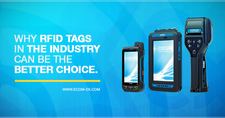While barcodes are based on optical identification, RFID tags are read via radio waves. In industrial plants, especially in the ex-industry, the objects are exposed to strong demands. Barcodes can fade, pollute, or be obscured by other objects due to UV irradiation. These are only a few circumstances in which the barcode can reach its limits.
RFID Tags, however, have the ability to be captured without direct visual confirmation, thus guaranteeing flawless identification even in challenging and harsh industrial environments. An RFID system always consists of at least one tag and one reader / writer unit. Depending on the type of construction, tags can be active or passive. The electromagnetic induction of the RFID reader activates passive tags, whereas active tags have their own battery. They send their information in periodic intervals and have a much higher range than passive tags. In RFID, you distinguish between different frequency ranges, from LF over HF and UHF, up to rarely occurring SHF (Super High Frequency).
In addition to better legibility, RFID tags are also significantly more robust against physical and chemical environmental influences, such as abrasion and moisture. Furthermore RFID tags can be captured in groups, so that with a single scan, e.g. the volume of a complete euro pallet, can be recorded.
The significant difference between barcodes and RFID tags is primarily the handling of information storage. While the coded information of a barcode is permanently defined with its creation, it can be changed and adapted with RFID tags. Since RFID tags are not based on an optical system, they are also significantly less susceptible to falsification because they cannot be copied, photographed, or scanned.
Take a look at our devices with RFID readability:
